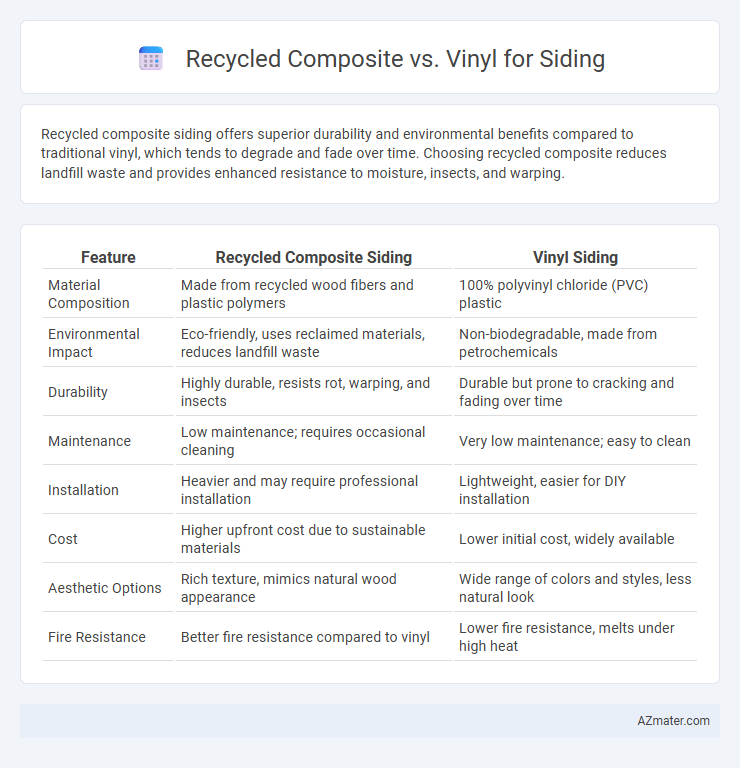Recycled composite siding offers superior durability and environmental benefits compared to traditional vinyl, which tends to degrade and fade over time. Choosing recycled composite reduces landfill waste and provides enhanced resistance to moisture, insects, and warping.
Table of Comparison
| Feature | Recycled Composite Siding | Vinyl Siding |
|---|---|---|
| Material Composition | Made from recycled wood fibers and plastic polymers | 100% polyvinyl chloride (PVC) plastic |
| Environmental Impact | Eco-friendly, uses reclaimed materials, reduces landfill waste | Non-biodegradable, made from petrochemicals |
| Durability | Highly durable, resists rot, warping, and insects | Durable but prone to cracking and fading over time |
| Maintenance | Low maintenance; requires occasional cleaning | Very low maintenance; easy to clean |
| Installation | Heavier and may require professional installation | Lightweight, easier for DIY installation |
| Cost | Higher upfront cost due to sustainable materials | Lower initial cost, widely available |
| Aesthetic Options | Rich texture, mimics natural wood appearance | Wide range of colors and styles, less natural look |
| Fire Resistance | Better fire resistance compared to vinyl | Lower fire resistance, melts under high heat |
Introduction to Siding Materials
Recycled composite siding combines reclaimed wood fibers and plastic to create a durable, eco-friendly exterior option that resists rot, insects, and warping. Vinyl siding, made from polyvinyl chloride (PVC), offers affordability and low maintenance but may lack the environmental benefits of recycled materials. Both materials provide moisture resistance and a range of design choices, making them popular for residential siding installations.
Recycled Composite Siding: Overview
Recycled composite siding is made from a blend of recycled wood fibers and plastic, offering superior durability and resistance to rot, insects, and weather compared to vinyl. This eco-friendly siding option reduces landfill waste while providing a natural wood appearance with minimal maintenance requirements. Its enhanced thermal insulation properties contribute to improved energy efficiency in residential and commercial buildings.
Vinyl Siding: Overview
Vinyl siding is a durable, low-maintenance exterior cladding material made from polyvinyl chloride (PVC) that offers excellent weather resistance and color retention. It is widely favored for its affordability, ease of installation, and a variety of styles and textures that mimic wood or other materials. Vinyl siding also provides effective moisture resistance and requires minimal upkeep, making it a popular choice for residential and commercial buildings.
Sustainability and Environmental Impact
Recycled composite siding offers superior sustainability by utilizing post-consumer materials, reducing landfill waste and conserving natural resources compared to vinyl siding, which primarily relies on non-renewable petroleum-based plastics. The production of recycled composite siding generates fewer greenhouse gas emissions and supports circular economy principles, whereas vinyl siding manufacturing emits harmful pollutants and is less biodegradable. Long-term environmental impact favors recycled composites due to their durability, recyclability, and reduced contribution to microplastic pollution relative to traditional vinyl options.
Durability and Longevity Comparison
Recycled composite siding exhibits superior durability compared to vinyl, resisting warping, cracking, and fading under extreme weather conditions due to its dense, engineered structure. Vinyl siding tends to degrade faster with prolonged exposure to sunlight and temperature fluctuations, often requiring replacement within 20-30 years. The lifespan of recycled composite siding extends beyond 50 years, making it a more cost-effective and sustainable option for long-term exterior cladding.
Aesthetic Versatility and Customization
Recycled composite siding offers superior aesthetic versatility with its ability to mimic natural wood grains, stone, and other textures, providing a wide range of design options. Vinyl siding, while cost-effective, typically has a more limited palette and texture variety, restricting customization opportunities. Homeowners seeking tailored exterior appearances benefit more from recycled composite materials due to their enhanced durability and customizable finishes.
Installation Process and Maintenance
Recycled composite siding typically features interlocking panels or planks that snap together or fasten with hidden clips, simplifying installation and reducing labor time compared to vinyl, which often requires precise nailing and overlap alignment. Composite materials demand less frequent maintenance, resisting rot, warping, and insect damage, while vinyl siding requires periodic cleaning to prevent discoloration and may crack in extreme temperatures. Both options offer DIY-friendly installation, but recycled composites provide greater durability and lower upkeep over the lifespan of the siding system.
Cost Analysis: Upfront and Long-Term
Recycled composite siding typically has a higher upfront cost than vinyl siding, but its durability and low maintenance can lead to significant long-term savings. Vinyl siding is more affordable initially but may require more frequent repairs and replacements over time, increasing overall expenses. Evaluating both options involves assessing installation costs, lifespan, and potential maintenance to determine the best value for homeowners.
Weather Resistance and Performance
Recycled composite siding offers superior weather resistance, with enhanced durability against moisture, UV rays, and temperature fluctuations compared to vinyl siding. Vinyl siding is prone to cracking, warping, and fading under extreme weather conditions, whereas recycled composite materials maintain structural integrity and appearance over time. Performance-wise, recycled composite provides better insulation and less maintenance, making it a robust choice for long-term exterior cladding.
Choosing the Right Siding for Your Project
Recycled composite siding offers superior environmental benefits, durability, and low maintenance compared to traditional vinyl, making it a sustainable choice for eco-conscious projects. Vinyl siding provides budget-friendly installation and a wide variety of styles, but it may lack longevity and can be prone to cracking or fading over time. Assessing factors such as climate resistance, project budget, and long-term maintenance will guide the selection between recycled composite and vinyl siding for the optimal building envelope.

Infographic: Recycled composite vs Vinyl for Siding
 azmater.com
azmater.com